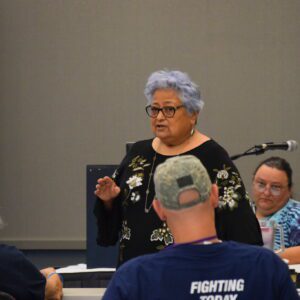March 19, 2024
Stand Up for Service
We’re currently experiencing the largest changes in the history of postal operations. Many of these changes have failed to demonstrate that they are in the best interests of our customers and are destined to negatively impact our communities. The 10-year plan can only be successful if it reduces productivity, degrades service, and increases costs related to expanding transportation. The reason for these changes is to accomplish throughput justification for machinery, and for producing unnecessary pollution. The USPS plan claims to yield a more efficient service, yet we haven’t seen it in the early stages. Contact your representatives and request that they stand up for service.
Productivity goals have already been reduced from 98 to 95 percent. Overnight delivery is no longer an item, Express Mail is on its way out, the First-Class package is gone and is now called Ground Advantage. That is combined with understaffed facilities, moving towards a five-day delivery standard for some mail, and moving to a logistics program that will only allow for one truck a day, in the morning, to drop and pick up the mail from the previous day at post offices. This will have a direct impact on rural America.
These changes often result in the Postal Service implementing Article 12 when they determine that there is an impact. With this continued attack on our service and jobs, collaboration is key. We continue to deal with a high number of Article 12 events across the country. With the vast number of changes already in place and impending changes coming faster than ever, working together is paramount if we plan to be successful. Being successful will require each of us to be accountable to ourselves and others, and more importantly engage in collaboration and information sharing. Being successful does not mean that none of our members will ever be impacted, but it does mean that the union will enforce the contract to the best of our ability.
The Crow Flies vs. The Car Drives
Part of the Article 12 process involves the Filling of Residual Vacancies MOU. How are the miles calculated and what is all the confusion about when dealing with Item #3 of the MOU?
APWU Special 21-Day Clerk Craft Posting reflected in Item #3 of the MOU provides that “…full-time regular Clerk Craft employees in an installation impacted by excessing, pursuant to Article 12.5.C.5, who request a transfer from an installation within the District or a 100-mile geographic radius through the eReassign Clerk Craft 21-Day Posting.”
JCIM Article 12 page 27: “The one hundred (100) mile radius for 21-day eReassign is an actual geographic radius from the impacted installation.” Sometimes referred to as “the crow flies.” A successful bidder in this venue will be permitted to take their seniority but will not have retreat rights back to their previous facility.
In the event these jobs have no takers, then Article 12 allows for these residual vacancies to be withheld if they’re within 50 miles of an impacted facility. If withheld, the local president must receive a notice to include the office of impact that it is being held. The radius for involuntary excessing, including the withholding of duty assignments, is measured by determining the shortest driving distance between the losing installation and the gaining installation. An easy way to remember this rule may be to remember that the crow flies 100 miles and the car drives 50 miles. Remember, driving distance could include going up and down a mountain, resulting in more miles than the crow would fly.
I, along with my colleague coordinators: Central Region Coordinator Amy Puhalski, Northeast Region Coordinator Tiffany Foster, Western Region Coordinator Omar Gonzalez, and Southern Region Coordinator Yared Wonde, stand strong and are here to help in any way we can. ■



